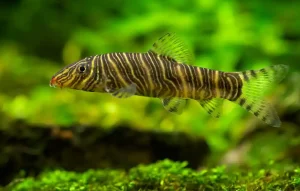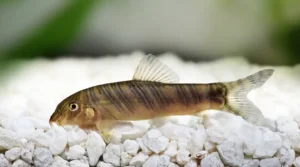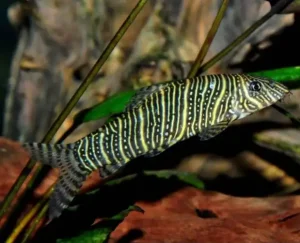The Zebra Loach is a beautiful and active freshwater fish that’s great for anyone new to keeping fish as pets. These friendly fish are easy to care for. Zebra Loaches love living in tanks with at least 30 gallons of water. They don’t like sudden changes in the water, so keeping the water conditions steady is very important.
In this guide, we’ll explain everything you need to know about caring for a Zebra Leach, so your new pet can thrive and bring lots of joy to your tank.
Origins and Habitat:
The Zebra Loach, also known as Botia striata, was first discovered in 1920 by a scientist named Narayan Rao. He found these unique fish living in Mysore, a region in the Western Ghats mountains of southern India. Unfortunately, their natural habitat has been shrinking because of deforestation and pollution, so they now live in only four locations.
You can also find Zebra Loaches in parts of Bangladesh and northern India. They live in rivers and slow-moving streams in these areas.
Because its population in the wild is decreasing, the Zebra Loach is listed as an endangered species on the IUCN Red List.
In the wild, Zebra Loaches prefer slow-flowing waters. These places often have a mix of fine gravel, sand, and leaf litter at the bottom. There are also some boulders and patches of bedrock scattered around. These fish love shady spots under forest canopies, where the light is dim and peaceful.
Appearance and color markings
The Zebra Loach is a small member of the Botia family, growing to about four inches long when fully grown, although some stay a little smaller. Its head is blunt and decorated with three pairs of tiny, whisker-like barbels around the nose. These include one pair near the mouth (maxillary) and two pairs on the snout (rostral). Young Zebra Loaches often have a reddish nose, but this color fades as they get older.

Zebra Loaches get their name from the bold vertical stripes covering their bodies.
The pattern is unique:
- The stripes near the head slant backward.
- The middle stripes slant forward.
- The ones near the tail are almost straight up and down.
The stripes come in different widths, ranging from thin to thick. Sometimes, the stripes break apart, creating a maze-like appearance.
Their stripes aren’t limited to the body; they cover the head and fins! The only exception is their belly, a plain cream color without patterns.
Candy Stripe Loach
The colors of a Zebra Loach’s stripes can vary. They range from pale yellow to deep brown or gray and sometimes have a bluish or greenish tint. This variety of colors has earned them another nickname: the Candy Stripe Loach.
Diet and Feeding: Zebra Loach
Zebra Loaches are omnivores, meaning they eat both plants and animals. They are not picky eaters, so you don’t have to worry about what to feed them. Zebra Loach Fish will happily eat live and frozen foods, like brine shrimp or bloodworms, flakes, sinking pellets, and tablets. They will also munch on any algae that grows on the surfaces and decorations in the tank.
Zebra Loaches are primarily active at night, so it is best to feed them after the lights are turned off. However, once they get used to their new home, they may also come out and become active during the day.
Since Zebra Loaches are bottom-dwellers, ensuring enough food falls to the bottom of the tank, especially if you have other fish that swim higher in the water, is essential. This way, the Zebra Loach can find food in its usual territory.
You can read here about zebra danio fish.
Breeding the Zebra Loach
Zebra Loaches were first introduced to the aquarium trade in 1952 and have become popular among fishkeepers. When you buy a Zebra Loach for your tank, it’s usually either wild-caught or bred in captivity. However, breeding Zebra Loaches at home has proven to be quite challenging for most hobbyists.

Despite this, commercial breeders have found success in breeding them by using hormones to encourage reproduction. While it’s still difficult for home aquarium owners to breed Zebra Loaches on their own, the fact that commercial breeding has worked shows that it’s possible under the right conditions.
Tankmates:
Zebra Loaches are friendly fish that enjoy living in groups and are best kept in shoals of at least five or more of their kind. These little swimmers often cruise around the tank together, making them a fun and lively addition to any aquarium.
While they’re more active at night, Zebra Loaches are still busier during the day than other loach species. They are generally peaceful and not aggressive, but their playful, boisterous nature can stress out timid or shy fish.
Zebra Loaches are a great choice for a community tank. They get along well with other Botia species and may even form schools with them. Suitable tankmates include fish like tinfoil barbs and the popular clown loach.
However, it’s important to avoid pairing Zebra Loaches with small bottom-dwelling fish, such as corydoras, because they might compete for space and occasionally show aggression in these situations.
You should also avoid housing them with fish with long, flowing fins, like angelfish, bettas, or long-finned guppies. These playful loaches may nip at even small tetras with delicate fins. Choosing the right tankmates creates a harmonious environment where your Zebra Loaches and their neighbors thrive.
Health and Diseases of the Zebra Loach
Zebra Loaches are generally hardy and can thrive if their aquarium conditions and diet are correct. However, they are still susceptible to some common freshwater fish diseases, mainly because they have faint body scales and no scales on their heads. This makes them more vulnerable to specific health issues.

It’s also important to know that Zebra Loaches are sensitive to many medications used to treat fish diseases. If your Zebra Loach gets sick, it’s best to remove it from the main aquarium and treat it in a separate hospital tank. Many diseases that affect Zebra Loaches are caused by stress, which can happen when the water temperature is too cold or the water conditions change suddenly.
Ich (White Spot Disease)
One common illness that Zebra Loaches can get is called Ich (Ichthyophthirius), also known as white spot disease. Ich is a parasite that affects many freshwater fish, including Zebra Loaches. It shows tiny white dots on the fish’s body, gills, fins, and tail.
You can treat Ich with over-the-counter medications available at most fish stores. But since Zebra Loaches are sensitive to some treatments, it’s essential to carefully read the instructions on the medication to make sure it’s safe for your fish.
Skinny Disease
Zebra Loaches are also prone to a condition called skinny disease. If your loach is eating well and getting a healthy diet but still losing weight, it might have this disease. Internal parasites cause skinny disease and are relatively easy to treat with special medications at a local fish store.
Precautions to Prevent Disease
Anything you add to your aquarium, such as new fish, plants, decorations, substrate (gravel or sand), or live food, can bring bacteria or parasites into your tank. It’s a good idea to keep new fish in a separate quarantine tank for a week before adding them to your aquarium. You should also wash any new plants or decorations with a mild antibacterial solution to help keep your tank safe and healthy.
Conclusion:
Zebra Loaches (Botia striata) are peaceful and attractive fish that thrive in at least five groups of well-maintained aquariums. They are a great addition to a mature home tank setup and can thrive with proper care.
While Zebra Loaches will eat algae in the tank, providing them with a balanced diet is essential. This should include meat protein, vegetable wafers, and flakes to keep them healthy. These fish are not easy to breed in home aquariums, but you can find them at most pet stores.
With the proper care and attention, Zebra Loaches can be a lively and beautiful addition to your aquarium, bringing peace and charm to your underwater world.

1 thought on “Zebra Loach Fish Species Profile”
Comments are closed.